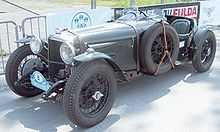Alvis Speed 20
| Alvis Speed 20 | |
|---|---|
 1933 Speed 20 SA 4-seater tourer by Vanden Plas | |
| Overview | |
| Manufacturer | Alvis |
| Production |
1932–36 1165 made[1] |
| Body and chassis | |
| Class | Touring car |
| Powertrain | |
| Engine | 2511 or 2762cc Straight-6 |
| Dimensions | |
| Wheelbase |
123 in (3,124 mm) SA 124 in (3,150 mm) SB-SD 130 in (3,302 mm) SD option[2] |
| Width |
65 in (1,651 mm) SA 66.5 in (1,689 mm) SB-SD [2] |
| Chronology | |
| Predecessor | Alvis Silver Eagle |
| Successor | Alvis Speed 25 |
The Alvis Speed 20 was a British touring car made between 1932 and 1936 by Alvis Ltd in Coventry. It went through four variants coded SA to SD.
Speed 20 SA
The engine for the Speed 20 was a heavily modified version of the one used in the preceding Silver Eagle cars, producing 87 bhp (65 kW).[1] Triple SU carburettors were fitted. The chassis was new and lowered by making it a "double drop" type where the side rails go over the front and rear axles. A centralised lubrication system was fitted allowing oil to be provided to moving suspension parts through a maze of pipework. Both front and rear suspension used half-elliptic leaf springs and the brakes with 14 in (356 mm) drums, mechanically operated. The four-speed manual gearbox was mounted in-unit with the engine.
The car could be fitted with a variety of coachwork. Standard bodies were a four-door saloon from coachbuilders Charlesworth or four-door tourer by Cross and Ellis, but some cars were supplied in chassis form and carried bodies by coachbuilders such as Vanden Plas.
Approximately 400 of the SA cars were made.
Speed 20 SB
The SB launched at the 1933 London Motor Show had a new chassis, slightly longer at 124 in (3,150 mm), with independent front suspension using a transverse leaf spring. The engine remained the same but the gearbox gained synchromesh on bottom gear and was mounted separately from the engine. A built-in jacking system was fitted as standard.
As with the SA, a wide range of bodies were fitted to the cars. Large Lucas 12 in (305 mm) P100 headlamps became standard, adding to the sporting appearance of the car.
Road test

The Times motoring correspondent tested and after describing its technical features in detail reviewed the car. Salient comments have been summarised as follows. The four-seater saloon was described as "distinctly fast in acceleration and speed" with a comfortable body such that a passer-by looks twice at it. A third person could be squeezed into the back seat. The four windows in the four doors allowed a good view all round. It was noted that each front wheel was independently steered and sprung in the manner introduced on the Alvis Crested Eagle and used on Alvis's racing cars since 1925, the aim being to provide good directional stability, road-holding and comfort.[3]
The steering and suspension was a star feature, the steering action exceptionally steady and light. The car does not heel or roll and there is little wheel bounce. The best speeds on second and third gears were 48 and 68 mph, 90 mph should be possible in top. Providing on the road such rapid acceleration and high rates the engine ran fairly quietly and with smoothness yet displaying exuberant spirits. The action of clutch and new gear change was pleasing.[3]
Speed 20 SC


For 1935 the engine grew to 2762 cc by increasing the stroke to 110 mm and the range designation became SC. Modifications were also made to the complex steering gear, and the front damping was improved. Twin electric fuel pumps were provided. At the rear the chassis was stiffened by having side members above and below the axle.
- 1935 Speed 20 SC drophead coupé by Lancefield
-
.jpg)
-
.jpg)
-
.jpg)
-
.jpg)
Speed 20 SD

by Lancefield

The final SD version for 1936 was similar to the SC but had a larger fuel tank and slightly wider bodywork. A 130 in (3,302 mm) wheelbase version became an option.
As with many cars of the time, bodies were getting more luxurious and hence heavier. To maintain performance the Speed 20 was replaced in 1937 by the 3.5-litre Speed 25 model.
References
External links
| Wikimedia Commons has media related to Alvis Speed 20. |